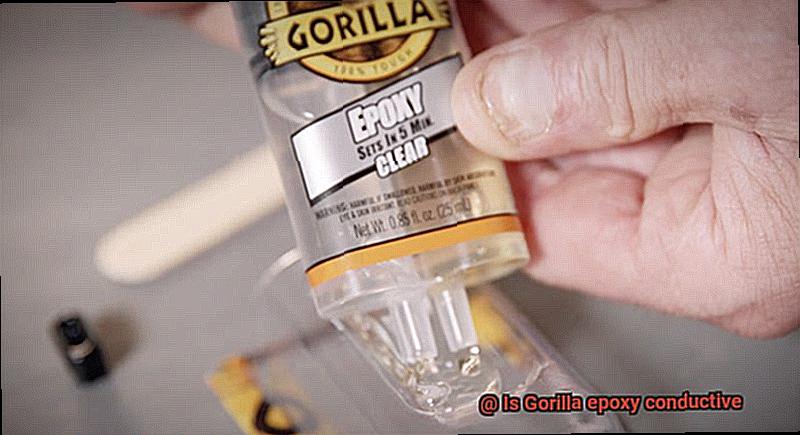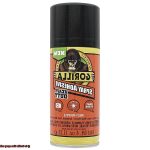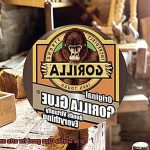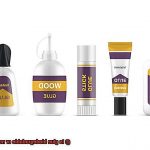Whether you’re a DIY daredevil, an electronics enthusiast, or just plain curious, we’re about to dive deep into the world of electrical properties. You’ve probably heard about Gorilla epoxy’s legendary strength and durability, but here’s the burning question: does it have what it takes to conduct electricity?
So grab your favorite mug of steaming coffee and let’s get amped up about Gorilla epoxy conductivity.
What is Gorilla Epoxy?
Contents
- 1 What is Gorilla Epoxy?
- 2 What is Conductivity?
- 3 Is Gorilla Epoxy Conductive?
- 4 Enhancing the Conductivity of Gorilla Epoxy
- 5 Factors Affecting the Conductivity of Gorilla Epoxy
- 5.1 Material Composition: Enhancing Conductivity with Metallic Particles
- 5.2 Mixing Ratio: Precision for Optimal Conductivity
- 5.3 Curing Time: Patience for Maximum Conductivity
- 5.4 Surface Preparation: Cleanliness for Effective Conductivity
- 5.5 Thickness of Application: The Goldilocks Zone for Conductivity
- 6 Specialized Conductive Epoxies
- 7 Advantages and Disadvantages of Using Gorilla Epoxy for Electrical Applications
- 8 Conclusion
When it comes to DIY projects and repairs, having a reliable adhesive is crucial. Enter Gorilla Epoxy, the go-to choice for amateurs and professionals alike. Known for its strength, versatility, and quick curing time, Gorilla Epoxy is the ultimate bonding solution.
Versatility is one of Gorilla Epoxy’s standout features. It can handle a wide range of materials including metal, wood, glass, ceramics, and most plastics. No matter the project or repair, this adhesive is up to the task, forming a strong bond on various surfaces.
Time is of the essence in DIY endeavors, which is why Gorilla Epoxy’s quick curing time is a game-changer. Within just five minutes of application, it sets and starts forming its strong bond. In a mere 24 hours, it reaches its full strength, allowing you to proceed without delay.
What sets Gorilla Epoxy apart from other adhesives is its resistance to water and extreme temperatures. Whether you’re working on an outdoor project or something exposed to harsh weather conditions, this adhesive won’t let you down. It remains strong and durable despite water exposure or extreme temperature fluctuations.
Applying Gorilla Epoxy is a breeze thanks to its easy-to-use syringe dispenser. The two components of the epoxy are dispensed in equal amounts through the syringe, ensuring a proper ratio without any guesswork involved. Just follow the manufacturer’s instructions carefully, ensuring clean surfaces free from dirt or grease.
What is Conductivity?
Today, we’re diving into the captivating world of conductivity and its relationship with Gorilla Epoxy. Have you ever wondered why certain materials conduct electricity while others don’t? Well, buckle up and get ready to explore the mysteries of conductivity. So sit back, relax, and let’s embark on this enlightening journey together.
- Conductivity refers to a material’s ability to conduct electric current.
- It is measured in siemens per meter (S/m) or mho per meter (℧/m).
- High conductivity signifies low resistance to current flow, while low conductivity signifies high resistance.
Types of conductivity:
- Electrical conductivity: The capacity to conduct electric current.
- Thermal conductivity: The capacity to conduct heat.
The Science Behind Conductivity:
Atomic structure:
- Conductive materials like metals possess loosely bound electrons that can move freely, enabling easy electron flow.
- Insulating materials tightly bind their electrons, restricting their movement and creating high resistance.
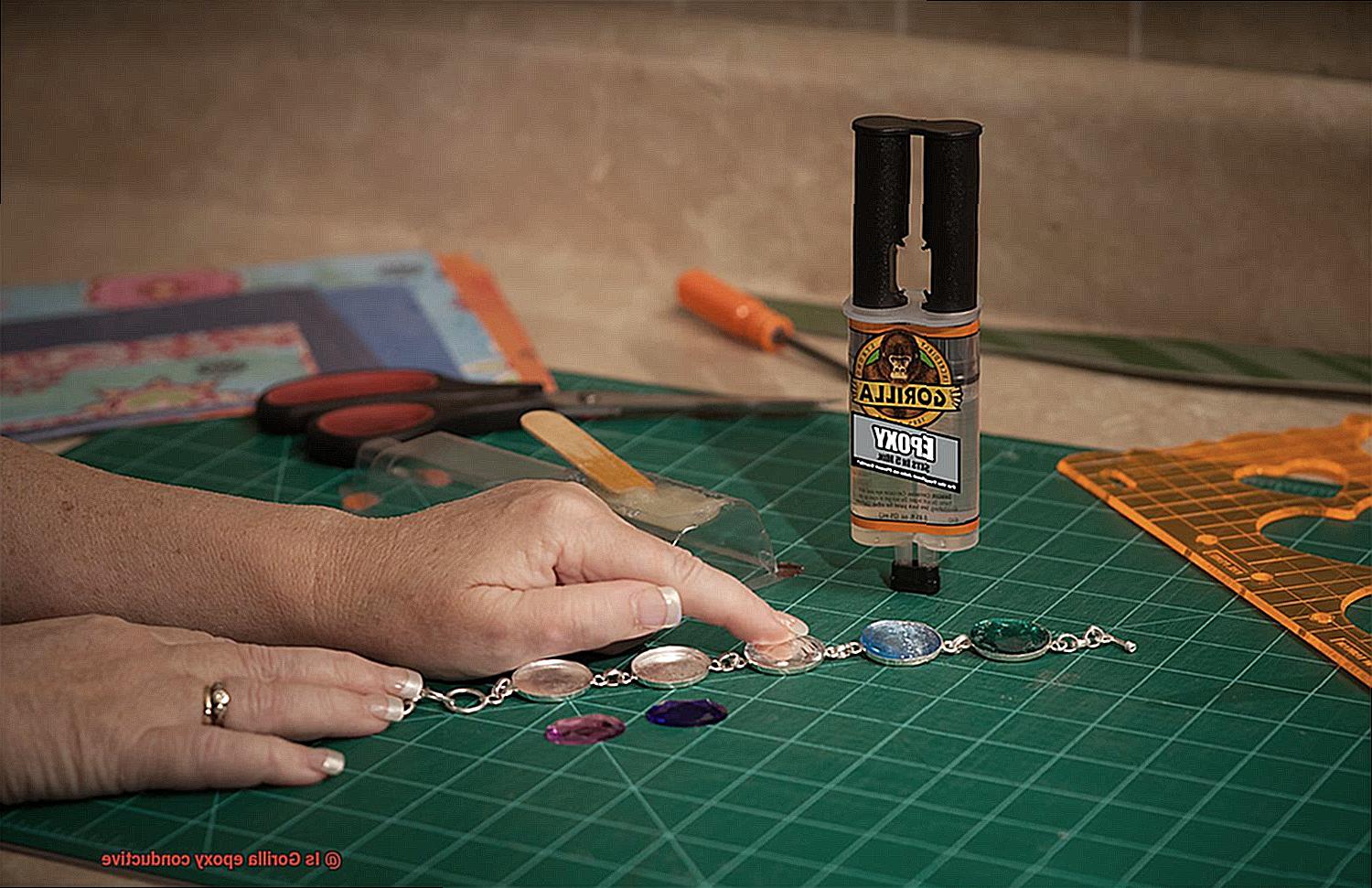
Charge carriers and mobility:
- Materials with delocalized electrons (such as metals) exhibit high electrical conductivity due to mobile charge carriers.
- Insulators lack mobile charge carriers, impeding current flow.
Temperature dependence:
- Conductivity can vary with temperature due to changes in charge carrier mobility.
- For instance, semiconductors display varying conductivity at different temperatures.
Gorilla Epoxy and Conductivity:
Now, let’s address the burning question: Is Gorilla Epoxy conductive?
- Gorilla Epoxy is an insulating adhesive primarily designed for bonding materials rather than conducting electricity.
- Its purpose is to create robust and durable bonds, making it an excellent choice for various DIY projects.
There you have it – a comprehensive understanding of conductivity and its relevance to Gorilla Epoxy. Armed with this knowledge, you can confidently choose Gorilla Epoxy for projects where electrical conductivity is not necessary. Remember, when it comes to bonding materials together, Gorilla Epoxy is your reliable sidekick, ready to tackle any DIY adventure.
Is Gorilla Epoxy Conductive?
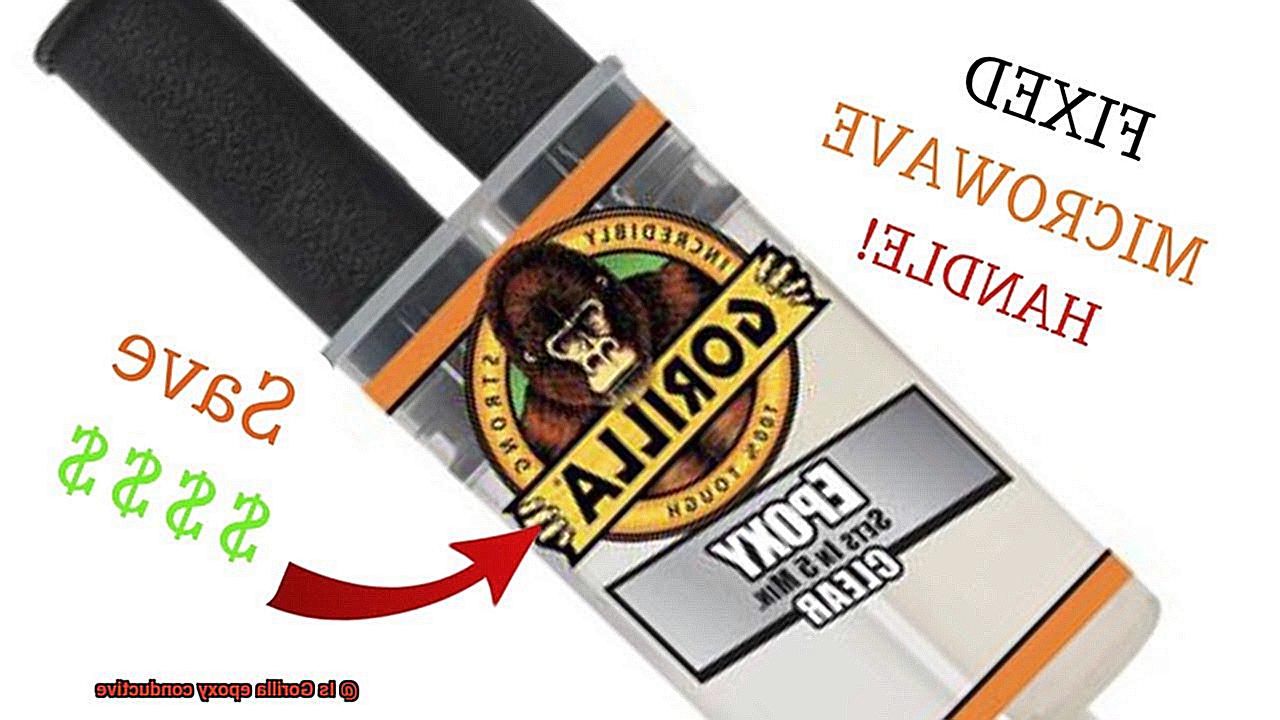
When it comes to selecting the perfect adhesive for your DIY projects, considering the electrical properties is crucial. In this blog post, we will delve into the question of whether Gorilla Epoxy is conductive or not. Let’s dive in and uncover the truth about this popular adhesive.
Composition of Gorilla Epoxy:
Gorilla Epoxy is a two-part adhesive, composed of a resin and a hardener. The resin is typically an epoxy resin, known for its strength, while the hardener is a polyamine compound. These robust materials form a powerful bond between various surfaces.
Conductivity Factors:
- Non-Conductive Materials: The primary components of Gorilla Epoxy, epoxy resin and polyamine hardener, are non-conductive materials. Consequently, they do not facilitate the flow of electric current.
- Potential for Minimal Conductivity: Although Gorilla Epoxy is not designed to be conductive, it may contain fillers or additives that introduce minimal conductivity. These additions can include conductive particles or compounds. However, the level of conductivity is generally negligible for most applications.
Specialized Conductive Adhesives:
If you require an adhesive with specific electrical conductivity properties, it is advisable to use specialized conductive adhesives. These adhesives are specifically formulated to offer reliable electrical conductivity, making them ideal for electronics, circuit boards, or soldering applications.
Conclusion:
In conclusion, Gorilla Epoxy is not inherently conductive due to its composition of non-conductive materials. Although there may be minimal conductivity due to fillers or additives, it is insufficient for most electrical or electronic applications. If you need an adhesive with specific electrical conductivity properties, opt for specialized conductive adhesives designed explicitly for those purposes.
Enhancing the Conductivity of Gorilla Epoxy
There are effective ways to enhance the conductivity of Gorilla epoxy and make it suitable for all your electrical needs.
One method to boost the conductivity of Gorilla epoxy is by incorporating conductive fillers or additives into the mixture. These fillers can include materials like silver, copper, or graphite, which are renowned for their exceptional electrical conductivity. By blending these fillers into the epoxy resin and hardener before applying the adhesive, you create a conductive pathway within the epoxy that facilitates the smooth flow of electrical current.
Another option is to utilize specialized conductive epoxies that are specifically formulated for electrical applications. These epoxies contain conductive particles in their formulation, ensuring superior electrical conductivity. Just like with the conductive fillers, these specialized epoxies can be employed for bonding electronic components, repairing circuit boards, or establishing electrical connections in your DIY projects.
However, it’s important to note that incorporating conductive fillers or using specialized conductive epoxies may impact other properties of the epoxy, such as strength and adhesion. Therefore, it’s crucial to consider the specific requirements of your application and select the appropriate type of Gorilla epoxy accordingly. Oftentimes, finding a balance between conductivity and other factors like durability or flexibility is necessary.
So, the next time you’re working on an electrical project and require a reliable adhesive with enhanced conductivity, consider integrating conductive fillers or utilizing specialized conductive epoxies with your Gorilla epoxy. With these enhancements, you can ensure that your adhesive not only securely holds everything together but also facilitates the seamless flow of electrical current.
Factors Affecting the Conductivity of Gorilla Epoxy
When it comes to conducting electricity, Gorilla Epoxy can be a powerful ally. However, several factors can influence its conductivity. In this article, we will explore the material composition, mixing ratio, curing time, temperature and humidity, surface preparation, and thickness of application of Gorilla Epoxy. Understanding these factors will help you harness the full potential of this adhesive.
Material Composition: Enhancing Conductivity with Metallic Particles
Gorilla Epoxy consists of a resin and a hardener, but its conductivity can be boosted by adding metallic particles such as silver, copper, or graphite. These conductive fillers create an electrically charged pathway within the epoxy, greatly improving its conductivity.
Mixing Ratio: Precision for Optimal Conductivity
Following the recommended mixing ratio is crucial. Any deviation from the manufacturer’s instructions may result in an epoxy with altered properties, including conductivity. Ensure accurate measurement and precise mixing of the resin and hardener components to achieve optimal conductivity.
Curing Time: Patience for Maximum Conductivity
Proper curing time is essential for Gorilla Epoxy to reach its maximum conductivity potential. During the curing process, chemical reactions occur between the resin and hardener, forming a strong bond. Allowing sufficient time for complete curing ensures optimal electrical conductivity.
Temperature and Humidity: Environmental Influences on Conductivity
Extreme temperatures can interfere with the curing process and alter the properties of Gorilla Epoxy, potentially impacting its conductivity. High humidity levels can also disrupt curing, affecting final electrical conductivity. Maintain suitable temperature and humidity conditions during application and curing.
Surface Preparation: Cleanliness for Effective Conductivity
Proper surface preparation is critical for achieving good electrical conductivity with Gorilla Epoxy. Dirty, oily, or rust-covered surfaces can hinder the epoxy’s ability to establish a conductive bond. Thoroughly clean and prepare surfaces before application to ensure optimal conductivity.
Thickness of Application: The Goldilocks Zone for Conductivity
The thickness of the Gorilla Epoxy layer can influence its conductivity. Thicker layers may have lower conductivity due to increased resistance. Follow manufacturer recommendations for applying the epoxy with a consistent thickness to achieve desired conductivity.
Specialized Conductive Epoxies
In the world of electronic devices, where tiny components work together seamlessly, there is a secret ingredient that holds everything in place: specialized conductive epoxies. These powerful adhesives not only create strong bonds, but they also allow for the flow of electrical current. Let’s dive into the fascinating world of specialized conductive epoxies and discover their advantages and considerations.
Advantages:
- Durable and reliable connections: Specialized conductive epoxies form long-lasting bonds between electronic components, ensuring the proper functioning of devices and systems.
- Versatility: These epoxies find their place in various industries, from electronics to aerospace, automotive, and telecommunications. When soldering is not feasible or desirable, these epoxies come to the rescue.
- Conductivity properties: The magic lies in the formulation of these epoxies. They contain conductive fillers or additives like silver, copper, nickel, or graphite, creating a pathway for electrical current to flow.
Considerations:
- Two-part system: Specialized conductive epoxies consist of a resin and a hardener. The resin provides adhesive properties, while the hardener improves electrical conductivity during the curing process.
- Choosing the right epoxy: Popular brands like Gorilla epoxy may be strong and versatile, but they are not specifically designed for electrical conductivity. While they may contain some conductive fillers, they are primarily formulated for general-purpose bonding.
- Factors to consider: When selecting a conductive epoxy, consider factors like curing time, temperature resistance, compatibility with different substrates, and electrical performance. Thorough research and expert consultation are essential to finding the most suitable epoxy for your application.
Advantages and Disadvantages of Using Gorilla Epoxy for Electrical Applications
When it comes to electrical applications, finding the perfect adhesive is crucial. Enter Gorilla Epoxy, a renowned name in the adhesive world. But before you dive headfirst into using it for your electrical projects, let’s explore the advantages and disadvantages of this mighty adhesive.
Advantages:
- Excellent adhesive properties: Gorilla Epoxy boasts exceptional bonding capabilities, ensuring a secure connection between various materials like metals, plastics, and ceramics. With this adhesive, you can rest easy knowing your electrical components will stay firmly in place.
- High temperature resistance: Electrical components generate heat during operation, and that’s where Gorilla Epoxy shines. It can withstand high temperatures, maintaining its adhesive properties even under extreme conditions, providing superior protection for your electrical connections.
- Water and chemical resistance: Moisture and chemicals can wreak havoc on adhesives over time, compromising the integrity of your electrical applications. But fear not. Gorilla Epoxy is designed to resist water and many common chemicals, offering long-lasting protection against potential damage.
- Versatility at its best: Gorilla Epoxy’s versatility knows no bounds. Whether you’re securing wires, repairing circuit boards, or encapsulating electronic components, this adhesive has got you covered. Its wide range of applications makes it a go-to choice for various electrical projects.
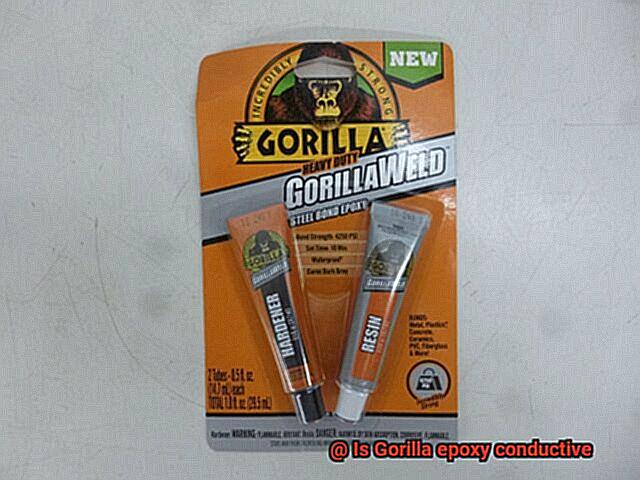
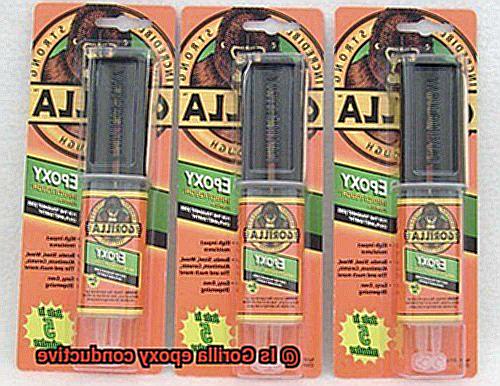
Disadvantages:
- Electrical conductivity concerns: One drawback of Gorilla Epoxy is its lack of inherent electrical conductivity. Unlike specialized electrically conductive epoxies, it may not provide a direct electrical path between components. This limitation can be a disadvantage in situations where conductivity is crucial for optimal performance.
- Cure time considerations: Patience is key when working with Gorilla Epoxy as it typically requires a longer curing time compared to fast-setting adhesives. This can be a drawback for time-sensitive projects or when quick repairs are needed. Plan accordingly and allow ample time for the adhesive to cure.
- Precision in application: Gorilla Epoxy’s strong bonding properties come at the cost of high viscosity, making precise application challenging. This can be especially tricky when working with small or intricate electrical components that require careful placement of the adhesive. Exercise caution and take your time to ensure accurate application.
- Limited reversibility: Once Gorilla Epoxy has cured and bonded materials together, reversing the bond becomes difficult without causing damage. This lack of reversibility can pose a challenge if modifications or repairs are required in the future. Take this into account when deciding on an adhesive for your electrical projects.
tU5bCl8WMoc” >
Conclusion
In conclusion, Gorilla Epoxy is inherently non-conductive. Its unique blend of epoxy resin and polyamine hardener creates a barrier that prevents the flow of electric current. However, it’s worth noting that Gorilla Epoxy may contain additives or fillers that introduce a minimal level of conductivity. These additions can include conductive particles or compounds, although their impact on conductivity is typically insignificant for most applications.
If your projects require an adhesive with specific electrical conductivity properties, it is advisable to turn to specialized conductive adhesives. These adhesives are meticulously formulated to provide reliable electrical conductivity, making them perfect for electronics, circuit boards, or soldering applications.
Although Gorilla Epoxy may not possess inherent conductivity, it boasts a plethora of advantages for general-purpose bonding and DIY projects. With its exceptional adhesive properties, impressive resistance to high temperatures, and resilience against water and chemicals, Gorilla Epoxy proves itself as a versatile choice for various materials and applications.
When selecting an adhesive, always consider the specific requirements of your project. If electrical conductivity is paramount, opt for specialized conductive adhesives tailored explicitly for those needs.

